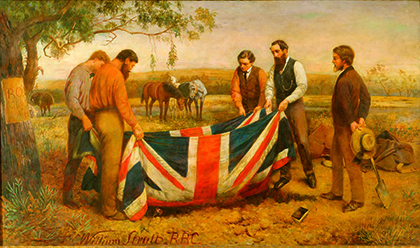 Relive Melbourne’s golden age, when Victoria became a separate colony, gold was discovered, bushrangers roamed and explorers launched bold expeditions into the Australian interior. These dramatic transformations were captured in the stunning artistry of William Strutt (1825–1915), whose work encompasses the brutal fury of the Australian landscape and the human drama of life in the mid-19th century.
Relive Melbourne’s golden age, when Victoria became a separate colony, gold was discovered, bushrangers roamed and explorers launched bold expeditions into the Australian interior. These dramatic transformations were captured in the stunning artistry of William Strutt (1825–1915), whose work encompasses the brutal fury of the Australian landscape and the human drama of life in the mid-19th century.
Strutt sought to create heroic, monumental canvases. He was the first artist to work in Australia who had studied at the most prestigious art academy in Europe, the École des Beaux-Arts in Paris, and he had the training to create such paintings. Disappointingly, his only large-scale history paintings on Australian themes were completed in England and did not bring him the admiration and financial security he had hoped for.
Curator Matthew Jones said the exhibition shows how an artist like Strutt, whose story, many believed, was one of thwarted artistic ambition, can now be seen in a fresh light. “Strutt’s contribution to Australian art has recently been reassessed,” said Mr Jones.
“His ability to draw the human figure and execute a large and complex composition sets him apart from other artists working in Australia in the mid-nineteenth century. His images emphasise the dangers of colonial life, from getting lost in the bush to bushranger bail-ups and bushfires.”
A superb draughtsman and renderer of the human figure, Strutt’s ability to compose complex dramatic scenes is witnessed in large narrative works such as Black Thursday, February 6th, 1851 and The burial of Burke. The oil paintings, watercolours, portraits, prints, preparatory sketches and large-scale history paintings featured in the exhibition provide an unparalleled visual record of the hazards and hardships of colonial life.
Demonstrating the meticulous approach of an academically trained artist, Strutt was the first great exponent of history painting to work in Australia. His spectacular work depicting the brutal and beautiful Australian landscape, explorers and bushrangers is iconic and informs the way we envisage colonial life in the mid-nineteenth century.
The story of Strutt could be viewed as one of thwarted artistic ambition, but that would be to undervalue what remains. He left behind an extensive visual record of Australia in the 1850s and early 1860s. Heroes and Villains brings together significant works from the extensive collections of State Library Victoria, the National Library of Australia and other major Australian collections.
Heroes and Villains: Strutt’s Australia
Keith Murdoch Gallery – State Library of Victoria, 328 Swanston Street, Melbourne
Exhibition: 14 July – 23 October 2016
Free admission
For more information, visit: www.slv.vic.gov.au for details.
Image: William Strutt, The burial of Burke, 1911 oil on canvas; 122 x 204 cm, Gift of Mrs Otway Falkiner, 1944. State Library of Victoria
